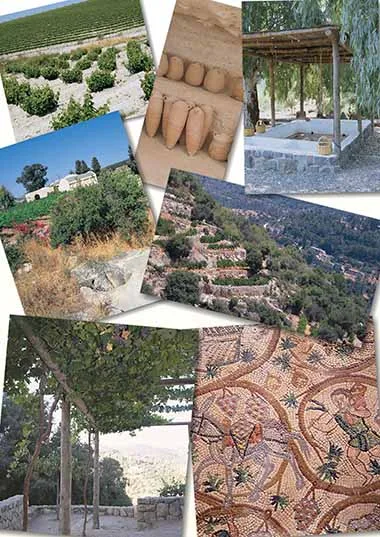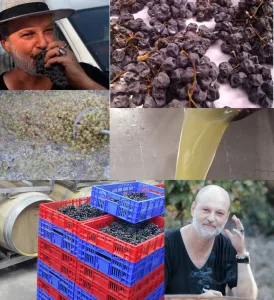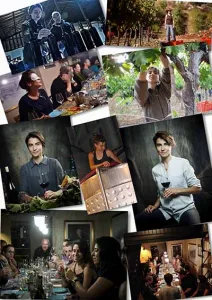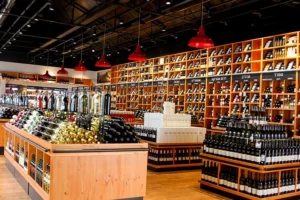If you ever hike in Israel, you are quite likely to come across a dilapidated flat, square stone trough. You may not know what it is, but you may have stumbled across an ancient wine press. They don’t carry a neon sign saying ‘Winery’ in big letters and they all differ in the way they look. There is no standard. However, they do all share the basic characteristics that identify them…..and there are simply thousands spread over the land of Israel. It always gives me the chills when I see one of these, because it connects winemaking today with winemaking in ancient times. Clos de Gat has one in its vineyard.
It reminds me that wine is a great ambassador of modern Israel, but it was also extremely important at the dawn of the Jewish people in Biblical times.
The first vineyard grower according to the Bible was Noah. He “planted a vineyard and drank the wine”. I like this story for a few reasons. Firstly, Noah’s Ark came to rest on Mount Ararat in Eastern Turkey. This is a case where archaeology supports the Bible narrative. Eastern Turkey was one of the earliest places where evidence of ancient winemaking has been found. In fact, winemaking arguably began between the Caspian and Black Sea, which is not far away.
Secondly, I imagine Noah took a cutting of a wild vine into the Ark with him, so he could plant it when the flood subsided. The idea of planting a vineyard is a statement of settling in one place, of becoming farmers instead of wandering nomads. Thucydides said man became civilized when he planted the vine and olive tree.
Finally, the text is very succinct. It talks about planting a vineyard and drinking the wine. It does not mention he made the wine. That is understood. We sometimes talk about wine growers, not grape growers. The French have a wonderful word ‘vigneron’. This is someone who looks after a vineyard to make wine. The winemaking is understood. Noah was a vigneron.
That he became drunk, was a first example of wine’s power. The sages explained these verses, by saying Satan buried the corpses of a lamb, lion, monkey and pig and watered Noah’s vineyard with their blood. As a result, when someone drinks a cup of wine, they feel like a lamb. Two cups and they feel bold like a lion. Three cups make them act like a monkey and four cups makes them behave like a pig!
The hunter, forager sought sweet fruits because they were tasty, had calories and good nutritional value. The sweetness of ripe grapes was prized. The journey from wild grapes to cultivated grapes took hundreds of years of natural selection and one of the motivating factors was that cultivated grapes proved to be sweeter.
The discovery of wine occurred by chance along the way. Each individual grape is a self-contained mini winery. If a grape skin split, the white yeast bloom on the skin, would naturally attack the sugars in the juice. Wine would result. No-one understood fermentation. Louis Pasteur would not unlock the secrets until the late 19th century. However, this ignorance only helped wine maintain its mystical quality. As they did not understand the process, wine swiftly became elevated to the status of a nectar of the Gods and all kinds folklore grew up to replace the lack of knowledge. They did understand that wine was potent and had properties to improve the mood, therefore it was prized all the more. The Greeks and Romans created Dionysus and Bacchus, the Egyptian Pharoahs were buried with their fine wines, so they could enjoy them in the after-life, and for Jews, wine was part of the sacrificial offering on the Altar of the Holy Temple.
Isaiah’s Song of a Vineyard (Isaiah 5) is a wonderful source of information about vineyards and viticulture. From this we learn that the vineyard was on a “fertile hill.” Vineyards like slopes. Sometimes here one comes across ancient terraces. There is more sun if facing the right way, drainage is better, and the vine will grow on slopes where other crops will not grow. The valleys could be used to grow grains, which were more essential for the diet. We are told a new vineyard has to be “dug up and cleared of stones”. That has not changed. If you visit an Israeli vineyard today, you will often find a pile of stones in a corner of a vineyard as evidence of the difficulties in clearing it. They planted the “choicest” vines. That has not changed either. Then, certain vines gave better results just like today. “He built a watchtower”. Many vineyards in ancient times had a watchtower to guard the precious fruit. We also learnt the vineyard may have had a wall around it and that the vineyard had to be pruned and cultivated. Not much new there.
Vineyards were not planted by grape variety. Until comparatively recently wine was made as a field blend, from whatever vines were in a particular area. Jewish farmers though, preferred not to mix species. The vine would naturally sprawl along the ground or grow up trees. If cultivated it had to be trained or grown on a pergola.
For harvesting, a pruning hook was used. In that famous phrase: “beat swords into ploughshares and spears into pruning hooks”, they used imagery that was familiar to the people. That is why so many stories in the Bible have references to vineyard, wine and grapes. It shows how important wine was to the economy. The simple person would understand messages wrapped in wine, because it was so much part of their daily life.
The grapes would be picked and quickly brought to the wine press, which was usually situated next door to the vineyard. The Ancient Israelites did not understand the science, but they did know if the grapes did not arrive quickly, the wine would be spoiled and become vinegar. Even today many wineries are situated close to vineyards. The classic Chateau in Bordeaux is surrounded by its own vineyards, as is true of estate wineries the world over. In Israel, wineries like Bravdo and the aforementioned Clos de Gat, sit amid their vineyards.
The grapes would be picked by all the family, filling up straw baskets, which would then be covered by vine leaves to protect them from the sun. Donkeys, wine’s oldest and most loyal harvest helpers, would take the grapes to the nearby wine press. Donkeys are still used in inaccessible vineyards in areas of the Eastern Mediterranean.
Farmers already knew that drying the grapes was good for preserving them as raisins to be used for food. They swiftly learnt also that making wine from sun dried grapes would make a sweeter wine. Grapes were sometimes laid out on mats next to the vineyard. Plus ca change, plus la meme chose. This method is one of the oldest winemaking techniques, still used today in Italy, Greece and Cyprus.
The wine press (or Gat in Hebrew) would be a flat limestone basin dug out of the bedrock. Maybe a wooden structure would be built overhead to protect the workers and wine from the sun. The grapes would be trodden by foot, an ideal solution, because the foot was heavy enough to break the skins, but not hard enough to crush the pips, which would have made the wine harsh and tannic. Today there are places in the world where this is still done…in port country for example.
The grape treaders would hold on to a rope or twine hanging from the wooden surround. It can be slippery work without anything to steady you. In Portugal, the ‘grape stompers’ lock shoulders, move backwards and forwards in a manic marching, rhythm…usually singing to help keep up the momentum.
The must, or juice, would flow through a channel chiseled in stone, into a lower collection area, which would be deep and narrower. This ‘well’ was called ‘the Yekev’ in Hebrew, which translates to winery! The plural of the word (Yekvei) came about because a medium sized wine press would have a number of ‘yekevs’. Large wineries in Israel to this day use the plural of the word in Hebrew, even if to denote a single winery.
In the yekev, fermentation would begin naturally. The wild yeasts from the skin of the grapes, would gorge on the sugar in the grapes. The result would be heat, carbon dioxide and that magic elixir called wine. Fermentation would take three days to a week. The wine would then be siphoned into a lower area, using twigs and thorns as a rustic filtration method, into large clay jars.
These would be amphora, with a pointed base and large oversized handles, like a pair of big ears. They would be put in cool, underground caves for storage and maturation. Sometimes olive oil would be gently poured on top of the wine or pine resin was added so the wine would not oxidize and turn to vinegar. The Greek Retsina is still flavored with pine resin. The Romans discovered the use of the cork as a closure to large containers. Hard to think all these years later we still close our wine with a bit of tree bark!
Wine was usually flavored to improve taste, cover impurities and act as a preservative. The additions could be sweet, like date honey or savory, like sea water. Flowers, herbs and spices were added…as is the case in a vermouth. I am not sure wine from then, would be recognizable to a wine drinker now.
We do know the wine was usually red. There are numerous mentions of blood red wine throughout the scriptures. The blessing Judah receives from Jacob (Genesis 49:11-12) is the clearest. “he will wash his garments in wine, his robes in the blood of grapes.”. Many don’t understand the text, but it does not take much imagination to interpret it as referring to the three separate stages of the harvest, the winemaking and drinking the wine. I like the idea that Judea was then a wine growing region of note. The Judean Hills today is one of our finest wine growing region appellations.
When the two spies return from Canaan to Moses, saying “It is a land of milk and honey and this is the fruit” (Numbers 13:1-33), showing a large, outsize bunch of grapes so big, it had to be carried on a pole between two men. It was a statement not just about the productivity of the land, but about the importance of wine. The grapes came from the Hebron area. Dr. Shibi Drori, winemaker of Gvaot Winery and researcher at Ariel University, is currently doing groundbreaking work on the indigenous varieties of the Holy Land. He once told me he saw an outsize bunch of grapes in the same area. For him it is a believable story, not a fairy tale. The southern Hebron Hills produces good wine today. In Yatir Forest there are no less than eighty wine presses and it is from where Yatir Winery sources its grapes.
The ultimate prophecy regarding wine is by the Prophet Amos: “My people Israel…..they shall plant vineyards and drink the wine thereof.”(Amos 9:14). The best imagery is: “the mountains shall drip sweet wine and all the hills shall flow with it.” (Amos 9:13). Looking at modern Israel, this is a prophecy that came true.
White wine was introduced only later. In the miracle of turning water to wine at the wedding feast at Cana, the wine must have been white, because they could not tell the difference from the water. Two other things I love about this story. Firstly, it was in the Galilee, where many of our best vineyards are today. Secondly it was commented “Everyone serves the good wine first, and when people have drunk freely, then the poor wine. But you have kept the good wine until now.” This is amusing and true. At a wine event or festival, a winery that values its wine will pour his better wines early in the evening when the serious wine lovers are out and about. By the time the late revelers come, who shove a glass under your nose and yell “Give me a red” or “give me your best wine”, you are already pouring your less expensive wine!
The Talmud mentions sixty types of wine. They are discussed in terms of quality and use, but not grape variety. There is not a Cabernet Sauvignon or Chardonnay amongst them! However, a great deal of information was given on inscriptions on the jars themselves. These were the forerunners of today’s labels.
Ancient Israel was a farming community. A vineyard had a special status. If someone had planted a new vineyard, he was even excused being called up to fight in the event of war. The making of wine was considered of prime importance. If a wine was made sour and undrinkable, the phrase “Baruch Dayan Emet” was used, as though someone had passed away.
Crops were essential to survival, so the growing period was crucial. The three pilgrimage festivals of Passover, Shavuot and Succot allowed farmers to give thanks for a bountiful harvest. Succot was the wine grape harvest festival. After the harvest there was a celebration. The young, single girls all dressed in white, would go and dance in the vineyard, hoping to attract the attention of the eligible young men.
In ancient times, grapes were one of the blessed species. Wine was a mainstay of the economy and part of the religious ritual. The Eastern Mediterranean was the cradle of wine culture, long before the vine reached France and Italy. Wine was a symbol of Ancient Israel and the Jewish people. Today it is a symbol of modern Israel, its technology, agricultural prowess and terroir.
As for wines’ place in our society, we are told in the Psalms “Wine gladdens the hearts of man” and that the idyllic situation according to Micah is that “Each man shall sit under his vine and fig tree, and none shall make him afraid.” True then, as it is now.
Adam Montefiore has advanced Israeli wines for over thirty years and is referred to as the ambassador of Israeli wine. He is wine writer of the Jerusalem Post. www.adammontefiore.com
_________________________________________________
A wonderful source of information is contained in the book:
VINE AND WINE In The Archaeology of Ancient Israel by Amos Hadas Published by Kronenberg Publishing Co.
Photos: Dani Kronenberg Amphorae Photo: Dani Kronenberg, courtesy of the Israel Nature and Parks Authority Mosaic Photo: Dani Kronenberg, courtesy of the Israel Antiquities Authority.



















